
China’s manufacturing sector expands, beating market expectations, official August data shows
Manufacturing PMI at 50.4, but analysts warn nation’s economy still facing weak demand and lacklustre investment appetite
Manufacturing in China expanded last month, surveys released on Thursday suggested, indicating Beijing has more leeway to focus on carrying out economic reforms rather than introducing stimulus measures to boost the nation’s slowing economy.
It was the first time the two surveys covering mainly big state-owned firms and private businesses have shown expansion in manufacturing activity since November 2014, according to one economist.
China’s economy grew at the slowest pace in 25 years in 2015 and the authorities are attempting to shift its growth model away from government stimulus and traditional manufacturing towards the service sector and high-tech industries.
China’s official manufacturing purchasing managers’ index, which mainly reflects conditions at state-owned companies, came in much better than analysts expected at 50.4 last month, according to the National Bureau of Statistics and the China Federation of Logistics and Purchasing.
A reading above 50 indicates expansion, while one below means contraction.
The previous month’s reading was 49.9 and the market had expected a contraction to 49.8 in August.
The Caixin China General Manufacturing PMI, which is slanted towards smaller privately owned companies, dropped to 50 in August from July’s surprise uptick of 50.6, according to a separate survey compiled by Markit.
Economists said the relatively strong figures came despite restrictions on manufacturing to reduce air pollution ahead of the Group of 20 summit in Hangzhou in Zhejiang province this weekend.
“The official PMI surprised us on the uptick side,” said Raymond Yeung, chief economist Greater China at ANZ. “This reinforced our view that the People’s Bank of China will keep its monetary policy neutral, without hurrying need to issue new loosening policies.”
He noted, however, that economic headwinds remain, with weak external demand for goods and services and the poorer performance of smaller companies.
A sub index for manufacturing output in the official PMI showed a rise to 52.6 from July’s 52.1.
New orders edged up 0.9 percentage points to 51.3, while new export orders gained 0.7 percentage points to 49.7.
The official purchasing managers’ index outside the manufacturing industry edged down by 0.4 percentage points to 53.5 last month, signalling slowing growth in the services sector.
“For the first time since November 2014, both manufacturing PMIs are now at or above 50,” wrote Julian Evans-Pritchard, an economist at Capital Economics in a research note. “This ought to boost sentiment and suggests that earlier policy easing is still being supportive of economic activity.”
He said the PMI readings paint a fairly reassuring picture about the current state of China’s economy and he maintained the view that earlier policy stimulus would probably be sufficient to shore up growth until the end of this year.
JP Morgan economists wrote in a research note that China’s economic policy was likely to stay unchanged in the very near term.
“The economic data to be released in the next few weeks are important to gauge the growth dynamics, in particular whether the solid growth momentum in the second quarter will continue into the second half of this year,” the note said

